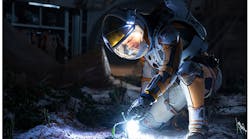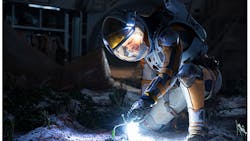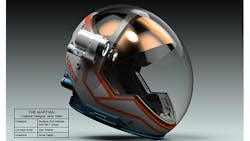1. Mark Watney, played by Matt Damon, has to grow his own food on Mars to survive. Apollo 13 was the winner of Machine Design’s World’s Greatest Engineering Movie (see “And the world's greatest engineering movie is . . .” on machinedesign.com) because of its realism. The winner next time around just may be Ridley Scott’s new movie, The Martian, starring Matt Damon and Jessica Chastain. The movie follows the book of the same name by Andy Weir, a programmer and author, very closely.
Matt Damon plays NASA astronaut Mark Watney, who is on a mission to Mars that goes awry. The rest of the team thinks Watney is dead and heads back to earth in their ion-powered ship, but Watney is not dead. What ensues is a believable presentation of Watney’s “MacGyver”-like ingenuity where he not only communicates with Earth but salvages, builds, and overcomes obstacles to move toward a rendezvous with a rescue mission. No big spoilers here.
I have heard a lot of people say that Apollo 13 is fictionalized and it could never happen that way. Well, it did and it took a lot of work from a lot of people on the ground and in space. They tackled an amazing array of problems and came up with engineering solutions that worked.
While fiction, this new movie takes its science and engineering seriously. Watney has to make water and grow his own food (Fig. 1) because there are insufficient amounts of both to survive until a rescue arrives. We actually now know that Mars is a bit friendlier than in the movie because of soil testing that has revealed more water and nutrients in the soil than was known when the movie was made.
2. Ridley Scott worked closely with NASA when creating items like the Surface Suit helmet.
NASA is already working on many of the items and concepts presented in the movie, from habitats to ion engines. Ridley Scott worked with Dr. Jim Green, director of the Planetary Science Division at NASA, to do the right stuff. Detailed designs for the movie’s habitats and surface suits (Fig. 2) were completed prior to filming, as was the creation of the objects used in filming. Hacking Pathfinder and Sojourner in the movie is possible, as they are in the same area on Mars that Damon is stranded--but Curiosity is on the other side of the planet.
A few minor things are off. The first windstorm is a bit more turbulent than a real Martian windstorm would be, but the second is on par with those already recorded on Mars. This includes the lightning. Likewise, Watney would probably not dig up the Multi-Mission Radioisotope Thermoelectric Generator (MMRTG). It would not have been buried because it would have human microbes on it that could grow in the Martian soil. NASA does use MMRTGs, but they would be kept above ground so a more realistic chore would be traveling to a remote location where the MMRTG would be powering some device.
I am definitely looking forward to seeing The Martian.


